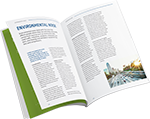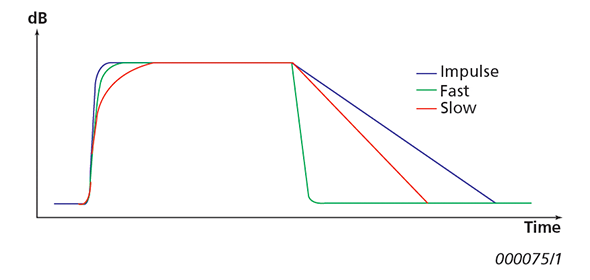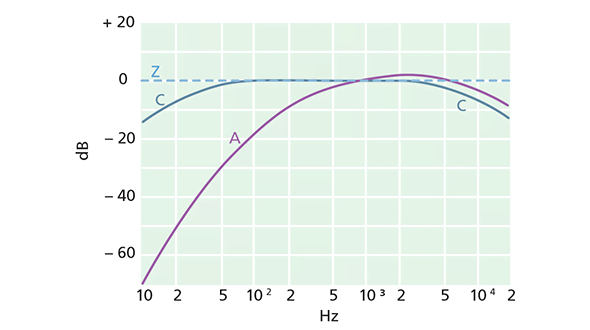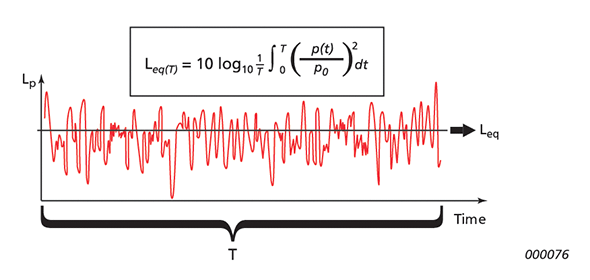
BUYERS GUIDE
CHOOSING YOUR MEASURING INSTRUMENT
WHAT IS A SOUND LEVEL METER USED FOR
Sound level meters are used to measure and manage noise from a variety of sources, including industrial plants, road and rail traffic, and construction work. With the addition of typical urban situations, such as concerts, leisure parks, and residential and commercial neighbors, the many different sources of sound and different characteristics, pose a variety of challenges for the professionals who assess them.
HOW DOES A SOUND LEVEL METER WORK
A sound level meter comprises a microphone, a preamplifier, signal processing, and a display. The microphone converts the sound signal to an equivalent electrical signal. The most suitable type of microphone for sound level meters is the condenser microphone, which combines precision with stability and reliability.
The electrical signal produced by the microphone is at a very low level, so it is made stronger by a preamplifier before it is processed by the main processor. Signal processing includes applying frequency and time weightings to the signal as specified by international standards such as IEC 61672 – 1, to which sound level meters conform.
TIME WEIGHTING
Time weighting specifies how the SLM reacts to changes in sound pressure. It is an exponential averaging of the fluctuating signal, providing an easy-to-read value.
The analyzer applies Fast, Slow, and Impulse (or ‘F’, ‘S’ and ‘I’) time weightings, which are the required weightings according to most international and national standards and guidelines. Environmental assessment standards usually specify which time weighting to use.
The signal is processed through the weighting filters, and the resulting sound pressure level is displayed in decibels (dB) referenced to 20 μPa on the analyzer’s screen. The sound pressure level values are updated at least once per second.
Assessing a fluctuating noise level means getting a value for a level that is, in simple terms, the average level. The ‘equivalent continuous sound level’, Leq, is known around the world as the essential averaged parameter. Leq is the level that, had it been a steady level during the measurement period, would represent the amount of energy present in the measured, fluctuating sound pressure level. It is a measure of the averaged energy in a varying sound level.
It is not a direct measure of annoyance, though extensive research has shown that Leq correlates well with annoyance. Leq can be measured directly with most professional SLM’s (sometimes called an integrating sound level meter). If an A-weighting filter is used, it is expressed as LAeq, the measurement of the equivalent continuous sound level using the A-weighted filter network.
LEARN MORE:
TYPE 2250
SOUND LEVEL METER
FREQUENCY WEIGHTING
Frequency weighting adjusts how the sound level meter responds to different sound frequencies. This is necessary because the human ear’s sensitivity to sound varies according to the sound’s frequency. IEC 61672-1 defines frequency weightings A, C and Z, but other frequency weightings are occasionally used in specialized applications.
A-weighting – dBA/dB(A)
A-weighting adjusts a signal in a way that resembles the human ear’s response at medium-range levels. It is based on the 40 dB equal loudness curve. The symbols for the noise parameters often include the letter ‘A’ (for example, LAeq) to indicate that frequency weighting has been included in the measurement.
A-weighting is required for nearly all environmental and workplace noise measurements and is specified in international and national standards and guidelines. A-weighting filters cover the full audio range, 10 Hz to 20 kHz.
C-weighting – dBC/dB(C)
The response of the human ear varies with the sound level. C frequency weighting corresponds to the 100 dB equal loudness curve, that is to say, the human ear’s response at fairly high sound levels. C-weighting is mainly used when assessing peak values of high sound pressure levels. It can also be used, for example, for entertainment noise measurements, where the transmission of bass noise can be a problem.
Z-weighting – dBZ/dB(Z)
‘Zero’ frequency weighting is a flat frequency response between 10 Hz and 20 kHz ±1.5 dB excluding microphone response.
Today, the A-weighting network is the most widely used frequency weighting. C-weighting does not correlate well with subjective tests because the equal loudness contours were based on experiments that used pure tones — and most common sounds are not pure tones, but very complex signals made up of many different tones.
FREQUENCY ANALYSIS
When more detailed information about a complex sound is required, the frequency range can be divided up into sections or bands. This is done with electronic or digital filters, which reject all sound with frequencies outside the selected band. These bands usually have a bandwidth of either one octave or a third of an octave.
An octave is a frequency band where the highest frequency is twice the lowest frequency. For example, an octave filter with a centre frequency of 1 kHz admits frequencies between 707 and 1414 Hz but rejects all others. (The name octave stems from the fact that an octave covers eight notes of the diatonic musical scale). A third octave covers a range where the highest frequency is 1.26 times the lowest frequency.
The process of thus dividing a complex sound is termed frequency analysis and the results are presented on a chart called a spectrogram. After the signal has been weighted and/or divided into frequency bands, the resultant signal is amplified, and the Root Mean Square (RMS) value is determined in an RMS detector.
The RMS is a special kind of mathematical average value. It is of importance in sound measurements because the RMS value is directly related to the amount of energy in the sound being measured.
 FROM SIMPLE TO ADVANCED
FROM SIMPLE TO ADVANCED> SOUND LEVEL METERS
> VIBRATION METERS
> CALIBRATOR
THE DISPLAY
The display shows the sound level in decibels, typically with a descriptor showing the selected combination of time and frequency-weighting (eg; LAeq or LCpeak). The signal may also be available at output sockets, in either AC or DC form, for connection to external instruments such as a data acquisition system, to provide a record and/or for further processing.
CALIBRATION
Calibration is an adjustment of your SLM to measure and display correct values. The sensitivity of the transducer, as well as the response of the electronic circuitry, can vary slightly over time or could be affected by environmental conditions such as temperature and humidity.
While you are unlikely to ever experience a large drift or change in sensitivity with the SLM, it is nevertheless, good practice to regularly check the calibration of your SLM, normally before and after each set of measurements. This is best done by placing a portable acoustic calibrator directly over the microphone. This will provide a precisely defined sound pressure level to which the sound level meter can be adjusted.
In addition to checking calibration before and after measurements, many regulations and standards governing sound level measurements often also require that your SLM is calibrated in a laboratory once every 12 or 24 months.
INTERNATIONAL STANDARDS
International standards are important either because they are used directly or because they provide inspiration or reference for national standards. There are two main international bodies concerned with standardization.
The International Organization for Standardization (ISO) deals primarily with a methodology to ensure that procedures are defined to enable the comparison of results. The International Electrotechnical Commission (IEC) deals with instrumentation to ensure that instruments are compatible and can be interchanged without major loss of accuracy or data.
IEC 61672
“IEC 61672 – Electroacoustics – Sound level meters” is the current international standard that sound level meters should meet to satisfy most modern regulations. It specifies “three kinds of sound measuring instruments” - the “conventional” sound level meter, the integrating-averaging sound level meter, and the integrating sound level meter.
The standard is published in three parts:
- Part 1: Specifications – specifies sound level meter performance and functionality for class 1 and class 2 sound level meters
- Part 2: Pattern evaluation tests – provides details of the tests necessary to verify conformance to all mandatory specifications given in IEC 61672-1. Used by test laboratories to ensure that instruments meet manufacturers claims
- Part 3: Periodic tests – describes procedures for periodic testing of sound level meters conforming to the class 1 or class 2 requirements of IEC 61672-1:2002
It defines the basic terminology including the central Rating Level parameter and describes best practices for assessing environmental noise.
WANT TO KNOW MORE?
ASK OUR EXPERTS
ISO 1996 − ASSESSMENT OF ENVIRONMENTAL NOISE
ISO 1996 “Acoustics − Description and measurement of environmental noise” is a central standard within environmental noise assessment, acting as a reference work on the subject and commonly referred to by regional standards and regulations.
ISO 1996 is divided into two parts:
- Part 1 2016: Basic quantities and assessment procedures
- Part 2 2017: Determination of sound pressure levels





